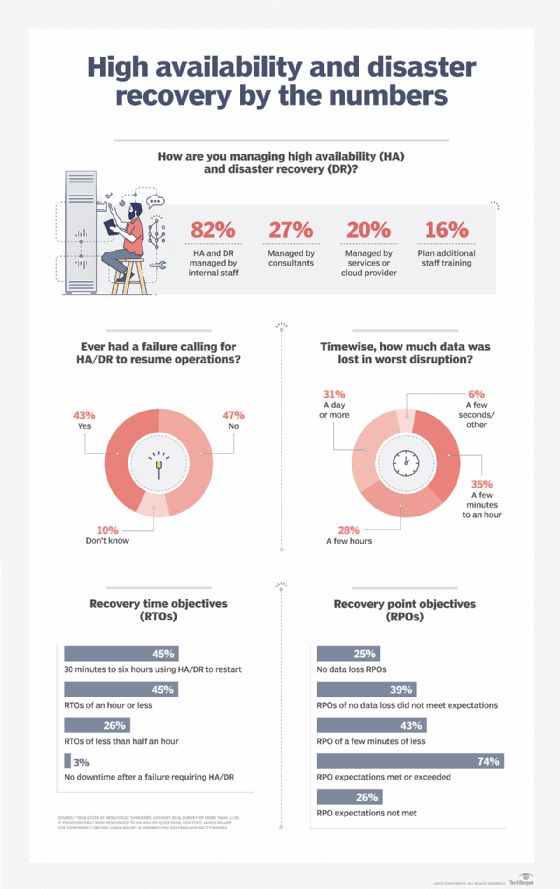
ag visuell - Fotolia
Compare VMware HA vs. DRS to prevent host failure
VMware HA and DRS are vSphere tools that provide high performance and continuous operability. Understanding the different use cases between these technologies is essential.
VMware vSphere provides IT administrators with several tools to prevent host failure, such as High Availability and Distributed Resource Scheduler. Both of these tools can help mitigate failures and ensure continuous operability of VMs, but the tools are intended for different use cases.
VMware HA and DRS offer similar capabilities for managing VMs and ensuring host operability. VMware HA relies on availability to provide what some experts refer to as "100% operational" for VMs and their hosts. DRS manages resources to balance computing workloads in a system, ensuring each VM and host has the appropriate amount of resources to complete tasks. Both work to prevent host failure but in different ways.
Use VMware HA to optimize and balance workloads
VMware HA is a technology that protects applications against a host server failure. If the VM on which an application is running fails, then the VM is automatically restarted on another host. VMware HA can provide availability for nearly any application, but it's particularly well suited for applications that lack native HA capabilities.
VMware HA works by monitoring the host servers within a resource pool to ensure that the system can detect each host's heartbeat. An agent running on the host produces the host's heartbeat. If VMware HA fails to detect a host's heartbeat, then it assumes that the host has failed. VMware HA then takes corrective action by automatically restarting the VM on another host within the resource pool.
Among VMware HA's key features is its ability to automatically detect server failure and automatically restart a VM. Additionally, VMware HA performs resource checks in order to make sure that sufficient capacity will be available when a VM needs to fail over to another host.
Use VMware DRS to monitor VMs and servers
VMware designed DRS to ensure optimal VM performance. VMware DRS achieves this by automatically distributing VMs across vSphere hosts based on workload characteristics. This ensures that VMs consume the host resources in an equitable manner and that a single host in a cluster isn't carrying a disproportionate share of the workload.
DRS is able to use other factors beyond host capacity when balancing VM workloads. For instance, DRS respects affinity and anti-affinity rules. Admins can also configure DRS to optimize power consumption. If DRS detects that the available host resources exceed the VM requirements, it can automatically place hosts in standby mode to reduce power consumption. Admins can then bring those same hosts back online if their resources are later needed.
DRS is not typically marketed as an availability tool, but it can help admins keep mission-critical workloads online in a failure situation. DRS constantly monitors the hosts within a cluster so that it can rebalance the workload if necessary. This monitoring process enables DRS to detect when the system adds new hosts to a cluster or when existing cluster nodes go offline. If DRS detects that a node is not online -- the node has failed -- it can use Storage vMotion to move VMs off of the failed node and onto a functional node.

Understanding the differences between VMware HA vs. DRS
VMware HA and DRS are each able to provide availability for VMs. The main difference between the two technologies is that VMware designed DRS to work in clustered environments, while HA enables admins to protect their VMs without having to deal with the cost or complexity of a failover cluster.
Although VMware HA and DRS are two completely different technologies, admins can use them together. When admins use HA in conjunction with DRS, the latter ensures optimal placement of a VM that is about to move and restart.
Provide continuous availability with FT
Aside from VMware HA and DRS, vSphere offers admins an additional technology known as Fault Tolerance (FT). Rather than simply failing a VM over to another host as HA and DRS do, FT maintains a replica VM on another host. In the event that the host containing the primary VM copy fails, admins can immediately activate the replica, preventing a failure.
VMware HA, DRS and FT might be best described as good, better and best. HA is an entry-level availability technology designed primarily for use in systems that have multiple vSphere hosts but don't have a failover cluster. VMware intended DRS for use in clustered environments and admins can combine it with HA to provide optimal placement of VMs as they fail over. FT is a true enterprise-class solution and VMware intends its use for admins' most mission-critical VMs. FT provides better protection than HA and DRS, but it can be complex and expensive to deploy.







